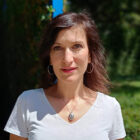C Summit of Two – A talk with Roberta Bosurgi & Delphine Moralis

It’s an interesting year to be a CEO – especially if you’re at the helm of an organisation supporting a sector focussed on solving, among others, social and environmental challenges.
There’s no shortage of those today. We’re all living through war, crises in energy and cost-of-living, and the lingering effects of the pandemic on education and the labour market. But for Roberta Bosurgi, CEO, EVPA, and Delphine Moralis, CEO, Philea, these challenging events comprise a multifaceted lens through which they see the work of impact investors, philanthropists and everyone in between.
We met Roberta and Delphine for a coffee at Philanthropy House, our shared home in Brussels, to discuss the intersection of their organisations’ missions, which are closely aligned (Philea nurtures foundations and philanthropic organisations in much the same way EVPA does impact capital providers). The two CEOs are experts in bringing people together for a purpose, and their insiders’ view of the collaboration process – where it succeeds and fails – shone throughout the conversation.
“There’s an element of trust,” Roberta reflected. “Everyone in our space talks about social impact, but there’s still a codified language and ideology that makes it difficult to for people coming from different parts of the ecosystem to communicate, understand and build trust. If you come from the corporate side of impact, and you start talking about profit, it can completely alienate people from NGOs.”
“You can only go as fast as the speed of trust,” Delphine added, paraphrasing a participant at the recent Philea Forum. She pointed out that collaboration also entails better engagement with the next generation. “They’re looking for purpose-driven roles,” said Delphine. “So, when we talk about collaboration, there’s this idea that we should strive to make our approach more intergenerational.”
What followed was a strategic discussion of how best to engage the future leaders of impact and philanthropy. “When we talk about the solutions we’re developing today,” said Delphine. “We’re not going to be the ones around to implement them: it’s the next generation – and hopefully they won’t be in a world that’s 2.5 degrees warmer than it is today. If we don’t involve them now, our chances of succeeding and doing anything meaningful are much, much lower. That’s where a question of perception comes in. With foundations, there’s a misconception about what a philanthropist is. In her book, In Defence of Philanthropy, Beth Breeze brings up the misconception whereby people think the average philanthropists are ‘male, white and dead.’ In reality, that’s not at all the case anymore. When we map foundations, we realise that they are involving more young people in their work, including in advisory roles and helping to define priorities for grants.”
Roberta and Delphine agreed that to further engage the next generation and create a bigger pool of talent for our space, education has to play a role.
“In universities they’re still teaching Friedman and the duty of maximising shareholder value,” said Roberta. “Sustainable economy is pushed off to the side. Why? We’re living at the dawn of the idea that ‘growth’ is not necessarily good. We’re realising the mistakes we made for the planet. And I think young people are catching on that there isn’t just one path of professional development and fulfilment; it’s broader than working for a Fortune 500 company. That starts with making social and environmental issues a proper part of education.”
It’s only natural for two CEOs to take the long view and consider the future of their space and its leaders. But Roberta and Delphine also recognised the need for swift action on today’s most pressing challenges. When faced with the question of how their organisations can do more right now, Delphine pointed out new pivoting tactics among foundations.
“Foundations are not traditionally emergency respondents,” said Delphine. “They tend to think long-haul, that’s where the value lies. But when you look at how they responded to the pandemic, you saw very agile waves, responding to grantees’ needs in a much more flexible way. When war broke out in Ukraine, we came together as a community with a discussion about what we can do to respond, listening to people on the ground to understand their needs and how philanthropy can add value. Within the first couple of days after the war, we launched two platforms, one with foundations and another with NGOs. Then, in just a couple of weeks, we had €176.5 million pledged.”
It’s a hopeful sign: deploying capital quicker where it’s needed most. But Roberta and Delphine also discussed the need to push further. “Increase the focus on the long-term financial stability of beneficiaries,” Roberta suggested, pointing out that this has long been a part of EVPA’s mission. “Combine the purpose of philanthropy with the most effective financial instruments and investment practices.”
Today’s diverse financial toolkit can strategically serve both foundations and impact investors; the details of how this happens and where the toolkit could be further developed were questions Roberta and Delphine discussed at length.
Roberta pointed toward further opportunities for foundations: “The latest data we’ve gathered shows foundations representing only 1% of the impact investment market in Europe. I think this could be an accelerator: foundations getting serious about what mechanisms could be used for the money to go further.”
Delphine brought up how tailoring these mechanisms requires careful consideration and no shortage of barriers for her stakeholders. “Foundations have a wide toolbox and want to tailor their methods depending on the context, the topic, the community, and of course, the legal or administrative limits,” said Delphine. “Whether it’s a grant or capacity building, it has to be tailored to the need.”
Philea and EVPA have both done tireless work in leveraging the value of today’s financial toolkit for their members and ecosystem; the fact that foundations and impact players alike are strategically exploring this toolkit’s possibilities and potential enlivened the further discussion. All the while, accelerating the greatest social and environmental good remained at the center.
It was supposed to be a fifteen-minute chat over coffee. At the hour mark, what coffee was left in the cups had gone cold. Roberta and Delphine didn’t seem to notice; there was still much more to discuss.
Authors


